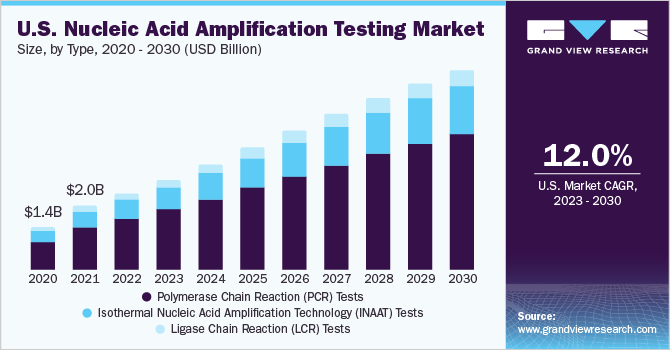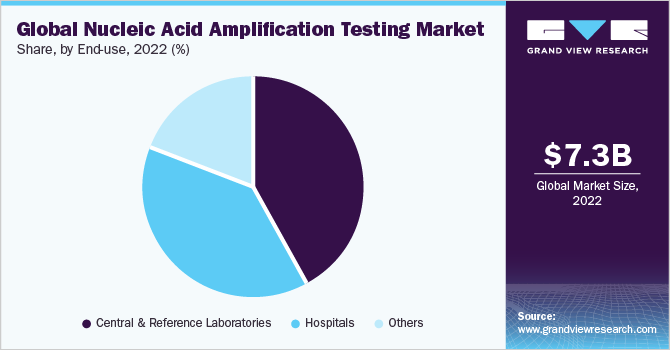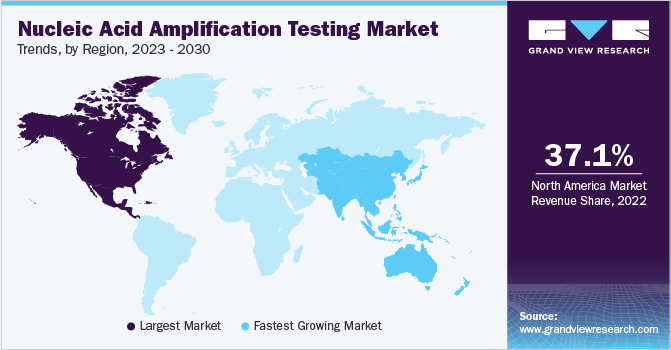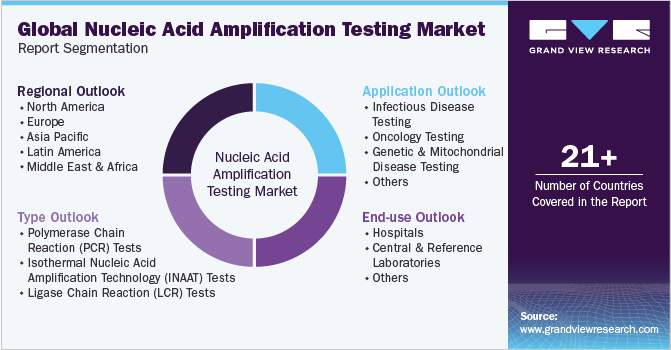- Home
- »
- Clinical Diagnostics
- »
-
Nucleic Acid Amplification Testing Market Size Report, 2030GVR Report cover
![Nucleic Acid Amplification Testing Market Size, Share & Trends Report]()
Nucleic Acid Amplification Testing Market Size, Share & Trends Analysis Report By Type (PCR, INAAT), By Application (Infectious Disease Testing, Oncology Testing), By End-use, By Region, And Segment Forecasts, 2023 - 2030
- Report ID: GVR-1-68038-388-1
- Number of Report Pages: 120
- Format: PDF, Horizon Databook
- Historical Range: 2018 - 2021
- Forecast Period: 2023 - 2030
- Industry: Healthcare
Report Overview
The global nucleic acid amplification testing market size was valued at USD 7.3 billion in 2022 and is anticipated to grow at a compound annual growth rate (CAGR) of 12.2% from 2023 to 2030. An increase in demand for advanced rapid diagnostics and rising R&D investments for developing novel biotechnological diagnostic techniques fuel the market growth. In addition, the high global prevalence of infectious diseases and the need for highly efficient testing alternatives to successfully manage disease outbreaks has propelled the demand for several nucleic acid amplification testing technologies. COVID-19 has increased demand for rapid and accurate testing methods, such as nucleic acid amplification, to detect the SARS-CoV-2 virus. Key players involved in the market have developed new product offerings, such as isothermal nucleic acid amplification technology-based tests, to meet the high demand for rapid and point-of-care testing.

For instance, in March 2020, Abbott Laboratories received Emergency Use Authorization (EUA) for its Abbott ID NOW COVID-19 test, which can deliver positive results within five minutes and negative results within 13 minutes. Such strategic initiatives fueled by the pandemic are expected to boost market growth in the near future.
As nucleic acid amplification testing offers the most precise detection of the target entities, the technique is most commonly used to detect infectious agents. The technique has also been extensively studied for diagnostic applications in cancer, personalized medicine, and forensics domains. As a result, a broad range of applications for nucleic acid amplification testing is expected to boost market growth during the forecast period.
Emerging infectious diseases, such as the Monkeypox virus, are opening new avenues for market growth. These are evident by the launch and regulatory approval of nucleic acid amplification test products for such diseases. For instance, in September 2022, Quest Diagnostics received the U.S. FDA’s Emergency Use Authorization (EUA) for its Quest Monkeypox PCR test launched in July 2022. Similarly, in August 2022, Todos Medical Ltd. commercially launched its Monkey Pox PCR-based test in the U.S. Hence, such novel infections are expected to expand the market growth further.
However, nucleic acid amplification methods, such as polymerase chain reaction (PCR), are severely limited by the requirement of thermal cycling and temperature control instrumentation, which restricts the adoption of PCR technologies in point-of-care applications. This factor can impede the growth of PCR-based technologies and restrict market growth in the near future.
Type Insights
Based on type, the market is segmented into polymerase chain reaction(PCR) tests, isothermal nucleic acid amplification technology (INAAT) tests, and ligase chain reaction (LCR) tests. The PCR tests segment accounted for the largest revenue share of 66.7% in 2022 and is anticipated to grow at the fastest CAGR of 12.4% during the forecast period. The technology enables rapid and sensitive detection of a broad range of target nucleic acid molecules. It can detect specific pathogens that may be difficult to culture in vitro. In addition, widespread penetration of PCR technology has enabled applications of the technique for detecting, quantifying, and genotyping various bacteria and viruses from several types of clinical specimens, including plasma, serum, semen, cerebrospinal fluid, and others. As a result, the PCR tests segment is expected to witness significant growth during the forecast period.
The Isothermal Nucleic Acid Amplification Technology (INAAT) tests segment is projected to expand at a rapid CAGR during the forecast period due to the introduction of novel technologies, such as loop-mediated isothermal amplification (LAMP), strand displacement amplification, and recombinase polymerase amplification, among others, that are broadening the scope of the applications for nucleic acid-based test products.
For instance, in June 2022, a research study published in the Analyst Journal demonstrated a new smartphone-integrated technology that can perform rapid Zika virus testing in a single blood drop with the help of the LAMP technology. Such advancements are anticipated to drive the segment and positively affect market growth.
Application Insights
The market is segmented based on application into infectious disease testing, oncology testing, genetic & mitochondrial disease testing, and others. The infectious disease segment accounted for the largest revenue share of 46.4% in 2022. This growth can be attributed to the widespread prevalence and rising incidence rate of infectious diseases such as influenza, sexually transmitted infections, and others. The COVID-19 testing sub-segment held the largest share in 2022 within the infectious disease testing segment due to the global presence of the pandemic and the launch of several new PCR tests.
For instance, in October 2020, Euro fins Central Laboratory launched its Empower DX SARS CoV 2 RT PCR test with the option for at-home sampling. Such product launches are expected to increase the market penetration of PCR tests and drive segment growth.
The oncology testing segment is expected to grow at the fastest CAGR of 15.3% during the forecast period from 2023 to 2030 due to the rise in R&D interests in developing novel cancer diagnostic alternatives and rapid progress in cancer research. For instance, in March 2022, researchers from Queen Mary University of London announced the development of the first PCR test to detect oral cancer. Such advancements are likely to fuel growth prospects for the nucleic acid amplification testing of other ontological conditions over the forecast period.
End-use Insights
The central and reference laboratories segment accounted for the largest revenue share of 41.9% in 2022 due to its extensive testing portfolio and coverage across multiple healthcare settings. In addition, supportive government initiatives are aiding in expanding the testing capacities of such laboratories. For instance, in June 2022, the Department of Health and Human Services (HHS) expanded the Monkeypox testing capacity to five laboratory companies, including Lab Corp., Quest Diagnostics, Mayo Clinic Laboratories, Aegis Science, and Sonic Healthcare.

The hospital segment is expected to grow at the fastest CAGR of 12.9% during the forecast period from 2023 to 2030. The rise in healthcare expenditure globally and the increasing role of nucleic acid amplification techniques for disease surveillance and prevention of outbreaks are the factors leading to the segment's growth. Similarly, growth in hospital testing capacities post-COVID-19 and the availability of high throughput testing capabilities can considerably boost the market prospects for nucleic acid amplification testing.
Regional Insights
North America dominated the market and accounted for the largest revenue share of 37.1% in 2022 due to the high extent of chronic disease prevalence and the presence of an established research and healthcare infrastructure. Similarly, demand for nucleic acid amplification tests is also driven by the increasing focus on point-of-care diagnostic methods and the region's high extent of disease prevention measures. For instance, in September 2022, BD and CerTest Biotec developed a molecular polymerase chain reaction (PCR) assay for the monkeypox virus. The rising acceptance of NAAT testing contributes to market growth in the region.

Asia Pacific is expected to grow at the fastest CAGR of 13.6% during the forecast period due to a large population and rising focus on the healthcare systems. High incidence of emerging infectious diseases such as Japanese encephalitis, Hendra, and Nipah virus infections can strengthen the market prospects for nucleic acid amplification testing.
Key Companies & Market Share Insights
The nucleic acid amplification testing market is highly competitive due to the strategic initiatives adopted by emerging and key players. Several new types of nucleic acid amplification tests have been launched in recent years. For instance, in September 2022, My lab Discovery Solutions launched its Patho Detect HPV Detection PCR Test to detect human papillomavirus (HPV) in high-risk individuals. The following are some of the major participants in the global nucleic acid amplification testing market:
-
F. Hoffmann-La Roche Ltd
-
Becton, Dickinson and Company
-
Danaher Corporation
-
Abbott Laboratories
-
Illumina, Inc.
-
Siemens Healthineers
-
bioMérieux SA
-
Novartis AG
-
Bio-Rad Laboratories, Inc.
-
Seegene Inc.
Nucleic Acid Amplification Testing Market Report Scope
Report Attribute
Details
Market size value in 2023
USD 8.6 billion
Revenue forecast in 2030
USD 19.2 billion
Growth rate
CAGR of 12.2% from 2023 to 2030
Base year for estimation
2022
Historical data
2018 - 2021
Forecast period
2023 - 2030
Report updated
September 2023
Quantitative units
Revenue in USD million/billion, and CAGR from 2023 to 2030
Report coverage
Revenue forecast, company ranking, competitive landscape, growth factors, and trends
Segments covered
Type, application, end-use, region
Regional scope
North America; Europe; Asia Pacific; Latin America; MEA
Country scope
U.S.; Canada; UK; Germany; France,; Italy; Spain; Denmark; Sweden; Norway; Japan; China; India; Australia; South Korea; Thailand; Brazil; Mexico; Argentina; South Africa; Saudi Arabia; UAE; Kuwait
Key companies profiled
F. Hoffmann-La Roche Ltd; Becton, Dickinson and Company; Danaher Corporation; Abbott Laboratories; Illumina, Inc.; Siemens Healthineers; bio Mérieux SA; Novartis AG; Bio-Rad Laboratories, Inc., See gene Inc.
Customization scope
Free report customization (equivalent up to 8 analyst’s working days) with purchase. Addition or alteration to country, regional & segment scope
Pricing and purchase options
Avail customized purchase options to meet your exact research needs. Explore purchase options
Global Nucleic Acid Amplification Testing Market Report Segmentation
This report forecasts revenue growth at global, regional, and country levels and provides an analysis of the latest industry trends in each of the sub-segments from 2018 to 2030. For this study, Grand View Research has segmented the global nucleic acid amplification testing market report based on type, application, end-use, and region:

-
Type Outlook (Revenue, USD Million, 2018 - 2030)
-
Polymerase Chain Reaction (PCR) Tests
-
Isothermal Nucleic Acid Amplification Technology (INAAT) Tests
-
Ligase Chain Reaction (LCR) Tests
-
-
Application Outlook (Revenue, USD Million, 2018 - 2030)
-
Infectious Disease Testing
-
COVID-19 Testing
-
Mosquito Borne Disease Testing
-
Influenza Testing
-
Sexually Transmitted Infections Testing
-
Hepatitis Testing
-
Tuberculosis Testing
-
Others
-
-
Oncology Testing
-
Genetic & Mitochondrial Disease Testing
-
Others
-
-
End-use Outlook (Revenue, USD Million, 2018 - 2030)
-
Hospitals
-
Central And Reference Laboratories
-
Others
-
-
Regional Outlook (Revenue, USD Million, 2018 - 2030)
-
North America
-
U.S.
-
Canada
-
-
Europe
-
U.K.
-
Germany
-
France
-
Italy
-
Spain
-
Denmark
-
Sweden
-
Norway
-
-
Asia Pacific
-
Japan
-
China
-
India
-
Australia
-
Thailand
-
South Korea
-
-
Latin America
-
Brazil
-
Mexico
-
Argentina
-
-
Middle East and Africa (MEA)
-
South Africa
-
Saudi Arabia
-
UAE
-
Kuwait
-
-
Frequently Asked Questions About This Report
b. The global nucleic acid amplification testing market size was estimated at USD 7.3 billion in 2022 and is expected to reach USD 8.6 billion in 2023.
b. The global nucleic acid amplification testing market is expected to grow at a compound annual growth rate of 12.2% from 2023 to 2030 to reach USD 19.2 billion by 2030.
b. North America dominated the nucleic acid amplification testing market with a share of 37.1% in 2022. This is attributable to the increasing extent of healthcare awareness and growth in demand for nucleic acid amplification-based diagnostics to prevent infectious diseases in the region.
b. Some key players operating in the isothermal nucleic acid amplification technology market include F. Hoffmann-La Roche Ltd; Becton, Dickinson and Company; Danaher Corporation; Abbott Laboratories; Illumina, Inc.; Siemens Healthineers; bioMérieux SA; Novartis AG; Bio-Rad Laboratories, Inc., Seegene Inc.
b. Key factors driving the market growth include increase in demand for advanced rapid testing options and rising R&D investments for the development of novel biotechnological diagnostic techniques.
Share this report with your colleague or friend.
![gvr icn]()
NEED A CUSTOM REPORT?
We can customize every report - free of charge - including purchasing stand-alone sections or country-level reports, as well as offer affordable discounts for start-ups & universities. Contact us now
![Certified Icon]()
We are GDPR and CCPA compliant! Your transaction & personal information is safe and secure. For more details, please read our privacy policy.
We are committed towards customer satisfaction, and quality service.
"The quality of research they have done for us has been excellent."





